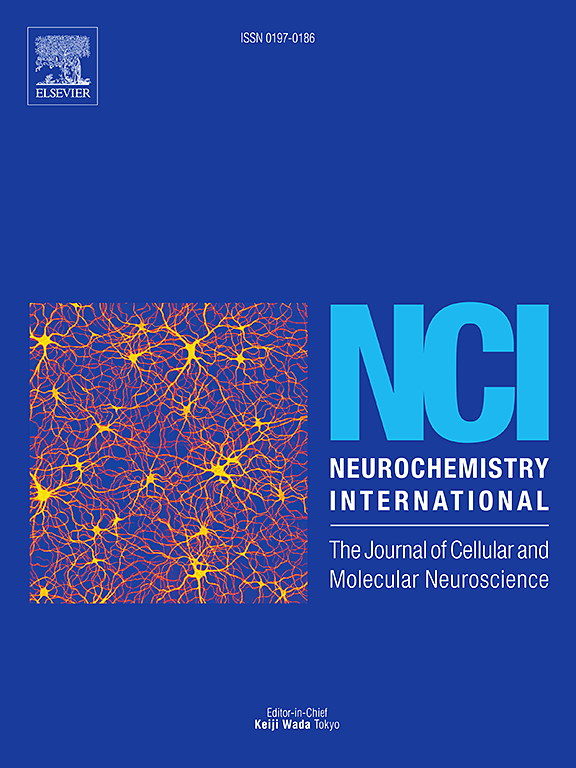Accelerated senescence exacerbates α-synucleinopathy in senescence-accelerated prone 8 mice via persistent neuroinflammation
IF 4.4
3区 医学
Q2 BIOCHEMISTRY & MOLECULAR BIOLOGY
引用次数: 0
Abstract
Parkinson's disease (PD) is characterized by the formation of α-synuclein (α-syn) aggregates, which lead to dopaminergic neuronal degeneration. The incidence of PD increases with age, and senescence is considered to be a major risk factor for PD. In this study, we evaluated the effect of senescence on PD pathology using α-synuclein preformed fibrils (PFF) injection model in senescence-accelerated mice. We injected PFF into the substantia nigra (SN) of senescence-accelerated prone 8 (SAMP8) mice and senescence-accelerated resistant 1 (SAMR1) mice. At 24 weeks after injection of saline or PFF, we found that SAMP8 mice injected with PFF exhibited robust Lewy pathology and exacerbated degeneration of dopaminergic neurons in the SN compared to PFF-injected SAMR1 mice. We further observed an increase in the number of Iba1-positive cells in the brains of PFF-injected SAMP8 mice. RNA sequencing revealed that several genes related to neuroinflammation were upregulated in the brains of PFF-injected SAMP8 mice compared to SAMR1 mice. Inflammatory chemokine CC-chemokine ligand 21 (CCL21) was upregulated in PFF-injected SAMP8 mice and expressed in the glial cells of these mice. Our research indicates that accelerated senescence leads to persistent neuroinflammation, which plays an important role in the exacerbation of α-synucleinopathy.
加速衰老会通过持续的神经炎症加剧衰老加速易感基因 8 小鼠的α-突触核蛋白病变
帕金森病(PD)的特点是形成α-突触核蛋白(α-syn)聚集体,导致多巴胺能神经元变性。随着年龄的增长,多巴胺能神经元退化症的发病率也会增加,而衰老被认为是多巴胺能神经元退化症的一个主要风险因素。在本研究中,我们使用α-突触核蛋白预成纤维(PFF)注射模型评估了衰老对帕金森病病理的影响。我们向衰老加速易感性8(SAMP8)小鼠和衰老加速抵抗性1(SAMR1)小鼠的黑质(SN)注射了PFF。在注射生理盐水或 PFF 24 周后,我们发现与注射 PFF 的 SAMR1 小鼠相比,注射 PFF 的 SAMP8 小鼠表现出强烈的路易病理变化,并加剧了 SN 中多巴胺能神经元的退化。我们进一步观察到,注射 PFF 的 SAMP8 小鼠大脑中 Iba1 阳性细胞的数量有所增加。RNA 测序显示,与 SAMR1 小鼠相比,注射 PFF 的 SAMP8 小鼠大脑中与神经炎症相关的几个基因上调。炎症趋化因子CC-趋化因子配体21(CCL21)在注射PFF的SAMP8小鼠中上调,并在这些小鼠的神经胶质细胞中表达。我们的研究表明,加速衰老会导致持续的神经炎症,这在α-突触核蛋白病的恶化中起着重要作用。
本文章由计算机程序翻译,如有差异,请以英文原文为准。
求助全文
约1分钟内获得全文
求助全文
来源期刊

Neurochemistry international
医学-神经科学
CiteScore
8.40
自引率
2.40%
发文量
128
审稿时长
37 days
期刊介绍:
Neurochemistry International is devoted to the rapid publication of outstanding original articles and timely reviews in neurochemistry. Manuscripts on a broad range of topics will be considered, including molecular and cellular neurochemistry, neuropharmacology and genetic aspects of CNS function, neuroimmunology, metabolism as well as the neurochemistry of neurological and psychiatric disorders of the CNS.
 求助内容:
求助内容: 应助结果提醒方式:
应助结果提醒方式:


